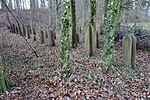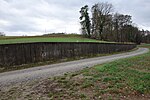Lock point Stammheim-Schlattingen
The Stammheim-Schlattingen blocking point (Army designation no. 611, 614, 617, 618) was a border fortification of Border Brigade 6 of the Swiss Army . It is considered a military historical monument of regional importance.
history
During the Second World War , the Rhine became a fortified border. The transfer options near Stein am Rhein and Diessenhofen , which were favorable for the attacker , were classified as dangerous by Border Brigade 6, because from there it was possible to advance across the depression near Unterstammheim into the Winterthur and Frauenfeld areas.
The key rooms in the section on the right (south of the Rhine) of the infantry regiment (Inf Rgt) 52 were: Herdern, Stammerberg, Schlattingen-Stammheim-Rodenberg, Dickihof-Wildensbuch-Trüllikon and Ossingen-Gisenhard .
The barrier stretches in a west-east direction across the depression on the border of the cantons of Thurgau and Zurich between Schlattingen and Unterstammheim, three kilometers from the state border (Rhine) . It is the last modernized barrier in Switzerland. The last three Centi bunkers in Switzerland were built here in 1994/95 . The natural obstacles, such as the Rhine, had to be supplemented by artificial means and reinforced with fire protection (Rhine bunkers, fortress mine throwers, mobile artillery, airplanes).
During the Second World War there was no second line of defense in the Stammheimer Senke. During the Cold War , the Swiss Army rated the danger so high that the strongest blocking point in the entire brigade room was created there. In order to block this axis permanently, three blocking points were set up (614, 617, 618).
The blocking point 611 (Oberstammheim) belonged to the Fusilier Battalion (Füs Bat) 160 of Inf Rgt 52.
The eastern blocking point 614 (east of Schlattingen) blocked the road from Stein am Rhein between Rodebärg and Stammerberg (two anti-tank garages for mobile anti-tank guns, etc.). Both 8.1 cm fortress mine throwers (A5575 Hohbühl and A5576 Junkerenboden) were able to act on this barrier.
The main barrier 617 (north of Unterstammheim) blocked the Stammheim depression over a width of around two kilometers. It was expanded from the 1970s to the 1990s (three Centurion anti-tank bunkers, an 8.1 cm Monoblock type 50 fortress mine launcher, a Pak garage). All blocking points were equipped with many shelters (U4, U12, ASU ). The last modernization was carried out with reinforced anti-tank traps (GPH66) and several 12 cm fortress mine launchers (modern canister ammunition, intelligent anti-tank bullets Stryx).
The western blocking point 618 (Schlattingen and Schlattingen Süd, room Füs Bat 152) had to block the western axis of incidence near Schlattingen (between Rodebärg and Joosebuck) (four anti-tank garages, an 8.1 cm fortress mine thrower monoblock type 50). The first blocking elements were installed from 1937. The mine thrower created in the 1960s was able to smear the blocking point and the bridgehead near Diessenhofen with its fire.
The Border Brigade 6 was disbanded in 1994. Most of the blocking points were taken out of service with the army reform in 1995 , the rest around 2004. The municipalities of Ober-, Unterstammheim and Waltalingen want to take over parts of the barrier including the gun bunker from the federal government in order to make them accessible to the public on a “historic bunker path”.
Investments
- Shelter Rodenberg West A 5510 ⊙
- Shelter Rodenberg Ost A 5511 ⊙
- Bleuelhausen shelter A 5526
- 8.1 cm fortress mine thrower 50 Hohbühl A 5575 ⊙
- 8.1 cm fortress mine thrower 50 Junkerenboden A 5576 ⊙
- 10.5 cm Centi bunker Furtmüli Nord A 5577 Geissbühl Nord ⊙
- 10.5 cm Centi bunker Furtmüli Süd A 5578 Geissbühl Süd ⊙
- 10.5 cm Centi bunker Steigbüel A 5579 ⊙
- 8.1 cm fortress mine thrower Türni F 6597 Unterlatt TG ⊙
- 8.1 cm fortress mine thrower 56 Kyburgerstein F 6525 Unterschlatt TG ⊙
- Pak-Garage Halden (VOBAG) F 6638 ⊙
- Shelter U12 Rotlenbuch (VOBAG) F 6647 ⊙
- Pak garage Fisterbuck (VOBAG) F 6653 ⊙
- Pak garage Guggerihalden (VOBAG) F 6657 ⊙
- Pak-Garage Vorhegi (VOBAG) F 6661 ⊙
- Pak-Garage Schlosserbuck (VOBAG) F 6700 ⊙
- Mooshölzli Company KP (VOBAG) F 6709 ⊙ shelter
- Pak garage Mooshölzli (VOBAG) F 6711 ⊙
- Pak-Garage Ungrien (VOBAG) F 6719 ⊙
- Pak Garage Weiher (VOBAG) F 6722 ⊙
- Ball bunker U4 Bleuelhausen A 6755
- Shelter U12 Späckhofwald (VOBAG) A 6763
- Vorhegi ASU 6S, 30 men F 6796 ⊙
- ASU command post company F 6912 ⊙
- Ammunition magazine type 22 Hohbühl F 6955 ⊙
- GPH66 and street barricades T 2660 ⊙
- GPH and street barricades T 2661 ⊙
- Tank wall GPH66 T 2663 ⊙
- GPH66 and street barricades T 2667 ⊙
literature
- Silvio Keller, Maurice Lovisa, Patrick Geiger: Military monuments in the canton of Zurich. VBS 2004 ar.admin.ch (PDF; 2.64 MB).
- Robert Gubler: Grenzbrigade 6 1938–1994. Verlag Neue Zürcher Zeitung, Zurich 1994.
Web links
Individual evidence
- ^ Silvio Keller, Maurice Lovisa, Patrick Geiger: Military-historical monuments in the canton of Zurich. VBS, 2004.
- ↑ Oberland Fortress: Lock No. 611 Oberstammheim ZH .
- ↑ Oberland Fortress: Lock No. 614 Unterstammheim ZH .
- ↑ Oberland Fortress: Lock No. 618 Schlattingen / Schlattingen Süd ZH .
- ↑ Commander and Staff of Border Brigade 6: The dissolution of traditional associations. In: General Swiss military magazine . No. 12/1994, p. 24.
- ↑ Martin Huber: Zurich's hidden "Russian lock". It is a relic from the Cold War: The Swiss Army's anti-tank barrier, which runs through the entire Stammertal in the north of the canton. In: Tages-Anzeiger . May 24, 2018.








